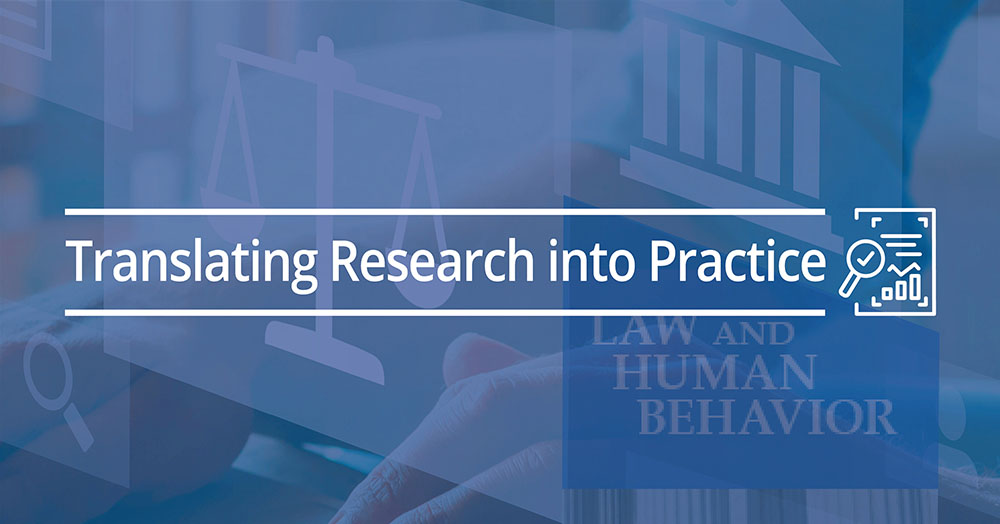Featured Article
Article Title
Detecting Criminal Intent in Social Interactions: The Influence of Autism and Theory of Mind
Authors
Zoe Michael - College of Education, Psychology and Social Work, Flinders University
Neil Brewer - College of Education, Psychology and Social Work, Flinders University
Abstract
Objective: Defense attorneys sometimes suggest that social-cognitive difficulties render autistic individuals vulnerable to involvement in crime, often arguing that theory of mind (ToM) difficulties that undermine inferences about others’ intentions underpin this vulnerability. We examined autistic adults’ ability to respond adaptively to criminal intent during interactions and whether difficulties were associated with poor ToM.
Hypotheses: Compared with nonautistic adults, autistic adults were expected to be less likely to respond adaptively to another’s criminal intent and less likely to do so early in interactions, with poorer performance associated with ToM difficulties. Method: We developed the Suspicious Activity Paradigm, in which autistic (n = 102)and nonautistic (n =95)adults listened (as if participating in an interaction) to audio scenarios in which cues suggesting their impending involvement in a crime gradually emerged. At periodic intervals, they were required to indicate how they would react toward the other person’s behavior, with response coding reflecting detection of, and adaptive responding to, suspicious activity.
Results: We observed similar patterns of suspicion and adaptive responses in autistic and nonautistic adults as the scenarios progressed. Regardless of diagnostic status, pronounced ToM difficulties and low verbal ability were independently associated with a lower likelihood of reporting suspicion and responding adaptively.
Conclusions: Our results do not support the perspective that autistic adults are uniquely vulnerable to crime involvement due to an inability to recognize and respond adaptively to suspicious behavior. The potential for heightened criminal vulnerability was associated with significant ToM difficulties (and verbal ability) regardless of autism diagnostic status, although such difficulties were more prevalent in the autistic sample. The finding that pronounced ToM difficulties may heighten criminal vulnerability for both autistic and nonautistic individuals challenges the validity of a generalized “autism” legal defense based on assumed rather than measured ToM difficulties.
Public Significance Statement: Defense attorneys sometimes suggest that social-communicative difficulties specifically associated with autism contribute to criminal vulnerability. In contrast, our research failed to detect any autism-specific difficulty in detecting and responding adaptively to criminal intent when interacting with others. Rather, difficulties reading others’ intentions during interactions posed problems regardless of the presence or absence of an autism diagnosis. When it is suggested in a courtroom that an inability to read others’ intentions likely contributed to an autistic individual’s criminal behavior, it should be supported by an objective assessment of their ability to interpret the intentions and motivations of others.
Keywords
autism, criminal intent, intelligence, mindreading, theory of mind
Summary of Research
“The current research had two main objectives. One was to examine whether, when compared with nonautistic adults of similar intellectual ability, autistic individuals can detect and respond adaptively during a social interaction when another individual is behaving suspiciously and, consequently, they are at risk of becoming ensnared in a criminal act.
The second objective was to determine whether ToM difficulties—difficulties in taking the perspective of others and reading their intentions—that purportedly characterize autistic individuals undermine their capacity to detect and respond adaptively to suspicious behavior on the part of others…
To pursue our first objective, we developed and used a novel paradigm—the Suspicious Activity Paradigm (SAP)—to measure autistic and nonautistic adults’ ability to detect and respond adaptively to suspicious behavior on the part of an interaction partner…
Our second objective was to examine whether ToM difficulties are associated with problems detecting and responding adaptively to another person’s criminal intent…. To examine whether ToM difficulties are associated with detecting and responding adaptively to other people’s suspicious behavior—our second overall objective—we examined whether ToM difficulties were associated with poor SAP performance” (p. 90- 91).
“We tested the hypothesis that, when compared with nonautistic adults, autistic adults had greater difficulty detecting and responding adaptively to suspicious behavior within interactions and possibly were less likely to do so relatively early in an interaction… Scoring of participants’ responses reflected their ability to detect suspicious activity and to respond in an appropriate manner to a problematic situation” (p. 92).
“...We compared large samples of autistic and nonautistic adults on the SAP to determine whether autistic adults have particular difficulties detecting and responding to criminal intent within interactions, and whether ToM difficulties were associated with any such difficulties… as expected, ToM scores were significantly lower for the autistic than the nonautistic group, [however] a substantial proportion of individuals in both groups scored at or near ceiling [likely] constraining the strength of relationships between ToM and SAP performance” (p. 96- 99).
“This highlights the importance of emphasizing individual characteristics within the context of an autism diagnosis when considering cases involving autistic defendants… Taken together, our findings indicate that a more nuanced understanding of autism and ToM as criminological risk factors for autistic adults is needed…
This study provided no evidence that, at the group level, autistic adults are less likely than nonautistic adults to detect that they may be involved in an interaction that may culminate in a crime and to respond adaptively. Further, although marked ToM difficulties were associated with problems detecting and responding to criminal intent on the part of others—and these difficulties were more prevalent in the autistic group—this issue was not confined to autistic individuals.
Our findings raise questions about the merits of using a generalized “autism” legal defense based on assumed cognitive and behavioral characteristics of those with an autism diagnosis and reinforce the importance of conducting careful formal assessments of the characteristics of the individual in question” (p. 103-105).
Translating Research into Practice
“First, we demonstrated remarkably similar patterns of adaptive responding and suspicion responses across the crime (and noncrime) scenarios in samples of autistic and nonautistic adults…
Second, those with higher degrees of autistic traits were more, rather than less, likely to
(a) report suspicious behavior at early scenario segments in three of the crime scenarios…
(b) respond adaptively in two of those scenarios..
Third, our regression analyses indicated that both verbal IQ and ToM — but not autism diagnostic status — were significant predictors of the number of suspicion and adaptive behavior responses reported by participants.
Fourth, comparisons of SAP responses revealed that, despite similar verbal IQ levels, individuals who obtained very low scores on the ToM task were less likely than high ToM performers to report suspicion and respond adaptively at early stages of the interactions.
Fifth, an examination of SAP response patterns from males and females hints at the possibility that female autistic individuals may be more likely to detect and respond to suspicious behavior….
Finally, when we examined the frequency with which autistic and nonautistic individuals indicated that they would comply with a problematic request, despite being suspicious about what they were being asked to do, we did not detect a significant difference…
Future research should continue to probe for a more nuanced understanding of the relationship between autism, ToM, and criminal behavior” (p. 102- 105).
Other Interesting Tidbits for Researchers and Clinicians
“ToM difficulties at an individual level, regardless of an autism diagnosis or presence of autistic traits, are associated with an impaired ability to detect suspicious behavior. And, given that there is likely to be a small subset of autistic adults with quite pronounced ToM difficulties, such difficulties may represent a significant barrier to detecting criminal intent in the behavior of others… Although ToM difficulties have often been represented as manifestations of a core deficit in autistic individuals and considered to be independent of intellectual level, it is important to note that the adult literature does not align with this conclusion, a finding that has implications for the expected differences between autistic and nonautistic adults in recognizing criminal intent in others” (p. 90- 91).
“(a) misreading another person’s reactions to inappropriate behavior may lead an individual to behave inappropriately and in a criminal manner toward that person,
(b) a relatively small subgroup of autistic individuals with significant ToM difficulties may be particularly vulnerable…
(c) other characteristics often associated with autism (e.g., intense restricted interests, sensory sensitivities, desire for social affiliations, or co-occurring conditions such as intellectual disability and other mental health concerns) could, perhaps in conjunction with ToM difficulties, render someone more vulnerable to criminal involvement” (p. 105).
Additional Resources/Programs
As always, please join the discussion below if you have thoughts or comments to add!















